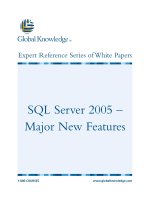Tài liệu SQL Statement Tuning pdf
Bạn đang xem bản rút gọn của tài liệu. Xem và tải ngay bản đầy đủ của tài liệu tại đây (171.44 KB, 26 trang )
11
Copyright © Oracle Corporation, 2002. All rights reserved.
SQL Statement Tuning
11-2
Copyright © Oracle Corporation, 2002. All rights reserved.
Objectives
After completing this lesson, you should be able to do
the following:
•
Control optimizer options
•
Use optimizer hints
•
Employ plan stability
•
Use stored outlines
•
Use SQL Trace and TKPROF
11-3
Copyright © Oracle Corporation, 2002. All rights reserved.
Overview
The purpose of this lesson is:
•
To provide methods to determine the resources
used by SQL statements:
–
Oracle Enterprise Manager
–
Statspack
–
Explain plan
–
SQL Trace and TKPROF
–
Autotrace
•
To determine which SQL statements possibly
require tuning
•
Not to tune the actual SQL statements
11-4
Copyright © Oracle Corporation, 2002. All rights reserved.
Optimizer Modes
There are two types of optimizer modes:
•
Rule-based:
–
Uses a ranking system
–
Syntax- and data dictionary-driven
•
Cost-based:
–
Chooses the path with lowest cost
–
Statistics-driven
11-5
Copyright © Oracle Corporation, 2002. All rights reserved.
Setting the Optimizer Mode
•
At the instance level:
–
optimizer_mode =
{Choose|Rule|First_rows|First_rows_n|
All_rows}
•
At the session level:
–
ALTER SESSION SET optimizer_mode =
{Choose|Rule|First_rows|First_rows_n|
All_rows}
•
At the statement level:
–
Using hints
11-7
Copyright © Oracle Corporation, 2002. All rights reserved.
Using Hints in a SQL Statement
SQL> CREATE index gen_idx on customers
2 (cust_gender);
SQL> SELECT /*+ INDEX(customers gen_idx)*/
2 cust_last_name, cust_street_address,
3 cust_postal_code
4 FROM sh.customers
5 WHERE UPPER (cust_gender) = ‘M';
11-8
Copyright © Oracle Corporation, 2002. All rights reserved.
Optimizer Plan Stability
•
Users can stabilize execution plans, to force
applications to use a desired SQL access path.
•
A consistent execution path is thereby maintained
through database changes.
•
This is done by creating a stored outline
consisting of hints.
•
The OPTIMIZER_FEATURES_ENABLE parameter
enables the optimizer to retain CBO features of
previous versions.
11-9
Copyright © Oracle Corporation, 2002. All rights reserved.
Plan Equivalence
•
SQL statement text must match the text in a
stored outline.
•
Plans are maintained through:
–
New Oracle versions
–
New statistics on objects
–
Initialization parameter changes
–
Database reorganization
–
Schema changes
11-10
Copyright © Oracle Corporation, 2002. All rights reserved.
Creating Stored Outlines
SQL> ALTER SESSION
2 SET CREATE_STORED_OUTLINES = train;
SQL> SELECT … FROM … ;
SQL> SELECT … FROM … ;
SQL> CREATE OR REPLACE OUTLINE co_cl_join
2 FOR CATEGORY train ON
3 SELECT co.crs_id,
4 FROM courses co
5 , classes cl
6 WHERE co.crs_id = cl.crs_id;
11-11
Copyright © Oracle Corporation, 2002. All rights reserved.
Using Stored Outlines
•
Set the USE_STORED_OUTLINES parameter to True
or to a category name:
•
Both CREATE_STORED_OUTLINES and
USE_STORED_OUTLINES can be set at the instance
or session level.
SQL> ALTER SESSION
2 SET USE_STORED_OUTLINES = train;
SQL> SELECT … FROM … ;
11-12
Copyright © Oracle Corporation, 2002. All rights reserved.
Using Private Outlines
Private outlines are:
•
Edited without affecting the running system
•
Copies of current storage outlines
•
Controlled using the USE_PRIVATE_OUTLINES
parameter
11-13
Copyright © Oracle Corporation, 2002. All rights reserved.
Editing Stored Outlines
Editing and using private outlines:
•
Create the outline tables in the current schema.
•
Copy the selected outline to private outline.
•
Edit the outline stored as a private outline.
•
To use the private outline, set the
USE_PRIVATE_OUTLINE parameter.
•
To allow public access to the new stored outline,
overwrite the stored outline.
•
Reset USE_PRIVATE_OUTLINE to False.
11-14
Copyright © Oracle Corporation, 2002. All rights reserved.
11-15
Copyright © Oracle Corporation, 2002. All rights reserved.
Maintaining Stored Outlines
•
Use the outln_pkg package to:
–
Drop outlines or categories of outlines
–
Rename categories
•
Use the ALTER OUTLINE command to:
–
Rename an outline
–
Rebuild an outline
–
Change the category of an outline
•
Outlines are stored in the outln schema
11-16
Copyright © Oracle Corporation, 2002. All rights reserved.
Oracle Enterprise Manager:
Maintaining Stored Outlines
11-17
Copyright © Oracle Corporation, 2002. All rights reserved.
Overview of Diagnostic Tools
•
Statspack
•
EXPLAIN PLAN
•
SQL trace and TKPROF
•
SQL*Plus autotrace feature
•
Oracle SQL Analyze
11-18
Copyright © Oracle Corporation, 2002. All rights reserved.
SQL Reports in Statspack
The following reports on statements are provided
by Statspack:
•
SQL ordered by gets
•
SQL ordered by reads
•
SQL ordered by executions
•
SQL ordered by parse calls
11-19
Copyright © Oracle Corporation, 2002. All rights reserved.
Performance Manager: Top SQL
11-20
Copyright © Oracle Corporation, 2002. All rights reserved.
Generate the Execution Plan
•
Can be used without tracing
•
Needs the plan_table table utlxplan.sql
•
Create the explain plan:
SQL> EXPLAIN PLAN FOR
2 SELECT last_name FROM hr.employees;
11-21
Copyright © Oracle Corporation, 2002. All rights reserved.
Query the plan_table Table
Query plan_table to display the execution plans:
•
Query plan_table directly.
•
Use script utlxpls.sql (hide Parallel Query
information).
•
Use script utlxplp.sql (show Parallel Query
information).
•
Use the dbms_xplan package.
SQL> SELECT *
2 FROM TABLE(dbms_xplan.display);
11-22
Copyright © Oracle Corporation, 2002. All rights reserved.
Using SQL Trace and TKPROF
To use SQL trace and TKPROF:
•
Set the initialization parameters.
•
Run the application.
•
Format the trace file with TKPROF.
•
Interpret the output.
SQL> ALTER SESSION SET sql_trace = True;
SQL> ALTER SESSION SET sql_trace = False;
11-24
Copyright © Oracle Corporation, 2002. All rights reserved.
Enabling and Disabling SQL Trace
•
At the instance level:
SQL_TRACE = {True|False}
•
At the session level:
SQL> ALTER SESSION SET
2 SQL_TRACE = {True|False};
SQL> EXECUTE dbms_session.set_sql_trace
2 ({True|False});
SQL> EXECUTE
2 dbms_system.set_sql_trace_in_session
3 (session_id, serial_id, {True|
False});
11-25
Copyright © Oracle Corporation, 2002. All rights reserved.
Formatting the Trace File
with TKPROF
$ tkprof tracefile.trc output.txt [options]
tracefile.trc output.txt
USER_DUMP_DEST
11-27
Copyright © Oracle Corporation, 2002. All rights reserved.
TKPROF Statistics
•
Count: Number of execution calls
•
CPU: CPU seconds used
•
Elapsed: Total elapsed time
•
Disk: Physical reads
•
Query: Logical reads for consistent read
•
Current: Logical reads in current mode
•
Rows: Rows processed
11-28
Copyright © Oracle Corporation, 2002. All rights reserved.
SQL*Plus Autotrace
•
Create the plan_table table.
•
Create and grant the plustrace role.
Autotrace syntax:
SQL> @$ORACLE_HOME/sqlplus/admin/plustrce.sql
SQL> GRANT plustrace TO scott;
SET AUTOTRACE [ Off | On | Traceonly ]
[ Explain | Statistics ]









